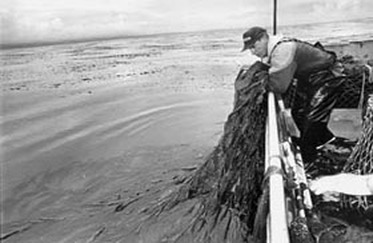Importance and Human Use
Kelp forests are important for a number of reasons. Historically, they have served as lush fishing grounds due to their immensely high productivity and their ability to concentrate biomass in relatively small areas [1]. It has been theorized that some of the earliest indigenous people traveled from Asia to North America (by way of the Bering Sea Land Bridge) during the last ice by following the kelp forests along the coast. Theories also suggest that kelp forest aided sailors as a navigational tool in the days before GPS and indicated that there was land near by. There is also a commercial importance for kelp itself in today's society. In California, the kelp industry is worth an estimated $250 million [2]. Ships outfitted with blades remove the top 3-6 feet of the kelp and the harvested material is then used in a wide array of products that are used everyday [3]. Algin (a product of kelp) is mainly added as an emulsifier to thicken the products that utilize it [4]. Additionally, their proximity to the coast, their discreet boundaries, and small areal coverage, they are easily accessible to scientists for manipulative studies [1]. The use of kelp forests for recreational activities is also important. They provide some of the best habitats for scuba diving and are frequented by recreational fishermen. However, the most important aspect of kelp forests is their environmental impact. They provide highly productive areas that serve as a haven for fish, invertebrates and mammals alike. They offer protection to many larvae fish of commercially important fishes (such as Rockfish) and are a staple coastal ecosystem that exhibit complex cross-species interactions.
Common Items Containing Kelp Products
|
|

